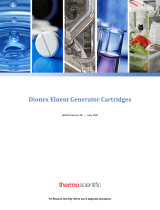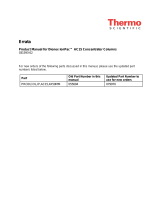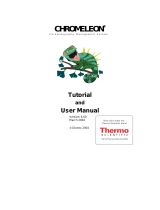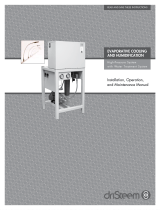Page is loading ...

for
AutoRegen®
Regenerant Cartridge Refills

AutoRegen® Cartridge Refill Document No. 032852-10 Page 1 of 7
PRODUCT MANUAL
for the
AutoRegen® REGENERANT CARTRIDGE REFILLS
ANION CARTRIDGE
(P/N 039564)
and
CATION CARTRIDGE
(P/N 039563)
IMPORTANT
FOLLOW THESE STEPS EACH TIME YOU CHANGE an AutoRegen®
REGENERANT CARTRIDGE
®DIONEX Corporation 2008
Document No. 032852
Revision 10
November 2008

AutoRegen® Cartridge Refill Document No. 032852-10 Page 2 of 7
TABLE OF CONTENTS
SECTION 1 - NEW AUTOREGEN REGENERANT CARTRIDGE RINSE .............................. 3
1.1 Removal of Old Cartridge ...................................................................................................................................... 3
1.2 Deionized Water Flush of New Cartridge ............................................................................................................. 3
1.3 Equilibration to New Regenerant .......................................................................................................................... 3
1.4 Reassembly of System ............................................................................................................................................. 3
SECTION 2 - CALCULATING CARTRIDGE LIFETIME .......................................................... 5
SECTION 3 - TROUBLESHOOTING GUIDE .............................................................................. 6
3.1 High Conductivity ................................................................................................................................................... 6
3.2 Excessive Back pressure Ruptures Pressure Relief Diaphragm ......................................................................... 7

AutoRegen® Cartridge Refill Document No. 032852-10 Page 3 of 7
SECTION 1 - NEW AUTOREGEN® REGENERANT CARTRIDGE RINSE
IMPORTANT
Follow these steps each time you change an AutoRegen® Regenerant Cartridge.
1.1 Removal of Old Cartridge
A. Remove the old cartridge from the system and dispose of it properly.
B. Temporarily remove the regenerant lines from the MicroMembrane Suppressor and connect the lines with a coupler.
C. Remove the return line from the MicroMembrane Suppressor to the top of the AutoRegen reservoir bottle and
temporarily direct it to a waste container.
1.2 Deionized Water Flush of New Cartridge
A. Empty the reservoir bottle and refill it with deionized water having a specific resistance of 18.2 megohm-cm.
B. Install the new AutoRegen Regenerant Cartridge as shown in Figure 1.
C. Ensure that the regenerant flow direction is from the top to the bottom of the AutoRegen Regenerant Cartridge. Pump
at least 400 mL of deionized water through the cartridge to waste.
1.3 Equilibration to New Regenerant
A. Empty the reservoir and refill it with 500 mL of fresh regenerant.
B. Pump 250 mL of regenerant through the cartridge to waste.
1.4 Reassembly of System
A. Remove the coupler and reconnect the regenerant lines to the MicroMembrane Suppressor.
B. Replace the return line from the MicroMembrane Suppressor (temporarily directed to a waste container) back into the
top of the AutoRegen reservoir.

AutoRegen® Cartridge Refill Document No. 032852-10 Page 4 of 7
AUTOREGEN TM
ANION CARTRIDGE
REORDER P/N 039564
CAUTION DO NOT EXCEE D 100 PSI MAX.
LOT N O .________ _____
039483-03
IMPORTANT
For maximum cartridge lifetime, always install the AutoRegen regenerant cartridge so that the regenerant flow
direction is from the top to the bottom of the cartridge as shown in Figure 1.
NOTE
For more detailed instructions, see Section 2.0 of the Product Manual for the AutoRegen Operators Manual
Document No. 032853.
Failure to follow the above procedures can cause contaminants to accumulate in the system. These contaminants
will degrade the overall performance and can eventually foul the MicroMembrane Suppressor.
Figure 1

AutoRegen® Cartridge Refill Document No. 032852-10 Page 5 of 7
SECTION 2 - CALCULATING CARTRIDGE LIFETIME
The lifetime of the AutoRegen Regenerant Cartridge depends on the eluent concentration and the flow rate. To minimize system
downtime, use the following formula to calculate the expected lifetime of the cartridge, record it, and then replace the cartridge
when the capacity is 90% expended. Use the following formula to calculate cartridge lifetime for your particular operating
conditions.
A. Calculate-the microequivalents-per hour of eluent:
(Normality of eluent) x (flow rate) x (60 min/hr) = μeq/hr
mN = μeq/mL
For example, (μeq/mL) x (mL/min) x (60 min/hr) = μeq/hr
NOTE
The normality of 2.2 mM Na2CO3, the standard anion eluent, is 4.4 mN Na+
B. Calculate the length of cartridge operation, using the appropriate formula as follows:
1. For anion applications:
500,000 divided by μeq/hr hours of cartridge use.
2. For cation applications:
350,000 divided by μeq/hr hours of cartridge use.
NOTE
When using a cation system, blanketing the regenerant in the reservoir with 1-2 psi of nitrogen or helium extends
the lifetime of the regenerant cartridge. For details, refer to the AutoRegen Operators Manual (Document No.
032853).

AutoRegen® Cartridge Refill Document No. 032852-10 Page 6 of 7
SECTION 3 - TROUBLESHOOTING GUIDE
The purpose of the Troubleshooting Guide is to help you isolate and solve routine operating problems. To use the Guide, locate
the description of the problem you are having and then follow the suggested course of action.
3.1 High Conductivity
The conductivity of the chromatographic system, including the AutoRegen, should be within 5 μS of the of the conductivity of
the system with no AutoRegen Regenerant Cartridge in-line. Use the equation in Section 2 to verify that the cartridge has not
expended.
The AutoRegen Regenerant Cartridge, regenerant or suppressor is contaminated or expended.
A. Turn OFF the AutoRegen pump.
B. Remove the AutoRegen Regenerant Cartridge from the system. Using a coupler, connect the cartridge inlet and outlet
lines. Turn ON the pump and monitor the background conductivity. If it is still too high, the regenerant is probably
contaminated and needs to be replaced. It is probable that the cartridge has been contaminated and should be rinsed
of contaminated regenerant.
1. Disconnect all liquid lines from the regenerant reservoir, dispose of the regenerant in the reservoir, and fill the
reservoir with deionized water having a specific resistance of 18.2 megohm-cm.
2. Disconnect the tubing installed in the top of the AutoRegen Regenerant Cartridge. Hold the cartridge upright to
prevent any liquid leaks and remove it from the slot. Hold the cartridge over a beaker, disconnect the tubing
installed in the bottom and drain all the regenerant from the cartridge into the beaker.
3. Reinstall the AutoRegen Regenerant Cartridge in the enclosure. Place the end of the outlet line in a waste container
and pump 1000 mL of high purity (specific resistance of 18.2 megohm-cm) deionized water through the cartridge
to waste. Afterwards, drain the remaining water from the cartridge into a beaker.
4. Connect the outlet line to the CHM, prepare fresh regenerant and resume normal operation.
C. If operating with fresh regenerant does not reduce the background conductivity, the suppressor may be the source of
the high conductivity. Remove the AutoRegen Regenerant Cartridge from the system. Using a coupler, connect the
cartridge inlet and outlet lines. Turn ON the pump and monitor the background conductivity. If it still too high, refer
to your suppressor manual for additional troubleshooting information. If the suppressor is not a problem, the cartridge
is defective. Contact the nearest Dionex Service Office about a replacement cartridge (see “Dionex Worldwide
Offices”).
The diaphragm in the pressure relief assembly has ruptured.
1. Check the piece of tubing to the exit side of the pressure relief assembly. If regenerant is flowing out of the tubing,
excessive back pressure has ruptured the diaphragm (see Figure 1).

AutoRegen® Cartridge Refill Document No. 032852-10 Page 7 of 7
3.2 Excessive Back pressure Ruptures Pressure Relief Diaphragm
A. Inspect the system tubing for kinks and blockages. Repair or replace tubing as necessary.
B. Turn OFF the AutoRegen pump. Install a plug in place of the pressure relief assembly.
C. Plumb the analytical pump (APM, GPM, etc.) with deionized water.
D. Remove the MicroMembrane Suppressor regenerant line from the suppressor. Route the outlet line to a waste
container.
E. Connect the analytical pump to the regenerant inlet port of the MicroMembrane Suppressor.
F. Begin pumping deionized water, having a specific resistance of 18.2 megohm-cm, through the suppressor regenerant
ports at 9.9 mL/min. The pressure should be less than 50 psi. If the pressure is greater than 50 psi replace the suppressor.
G. Remove the AutoRegen Regenerant Cartridge from the AutoRegen enclosure. Connect the analytical pump plumbed
with deionized water to the cartridge inlet. Route the cartridge outlet to a waste container with the suppressor
regenerant return line.
H. Begin pumping at 9.9 mL/min and monitor back pressure. The pressure should be less than 50 psi. If the pressure is
greater than 50 psi, replace the cartridge. If the pressure is less than 50 psi, continue with step J.
J. The MicroMembrane Suppressor and the AutoRegen Regenerant Cartridge are the most likely causes of high system
pressure. If the AutoRegen flow rate is less than 15 mL/min and the cartridge and the suppressor combined generate
less than 100 psi (as measured separately in steps 3–8), call the nearest Dionex Regional Office (see “Dionex
Worldwide Offices”) for further troubleshooting assistance.
WARNING
Do not substitute a plug for the pressure relief assembly during normal operation. The relief assembly is designed
to prevent the AutoRegen from operating at excessive back pressure which may damage the system and is a
potential safety hazard to the user.
/













